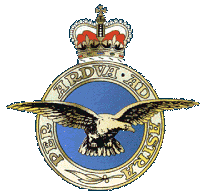
Crest of the Royal Air Force

Flag of the Royal Air Force

Royal Air Force Roundel
They sit no more at familiar tables of home;
They have no lot in our labours of the day-time;
They sleep beyond England's foam.
Moving in marches upon the heavenly plain,
As the stars that are starry in the time of our darkness,
To the end, to the end, they remain.
They mingle not with their laughing comrades again;
As the stars that shall be bright when we are dust,
Origins of the Royal Air Force
The Royal Air Force was officially formed on 1st April 1918 as a result of a merger between the Royal Naval Air Service (RNAS) and the British Army's Royal Flying Corps (RFC) which explains the naming convention of the ranks in the RAF, they being a combination of Army and Navy titles. The RAF's creation was in response to the increased German air offence in France, the inability of the RFC and RNAS to combat it and on 1st April 1918 all 3,000 aircraft and 67,000 personel were absorbed in to the new service. The first Chief of the Air Staff was an ex-RFC officer Major-General Hugh Trenchard, but as often happens, resigned only 13 days after the birth of the RAF due to political interference in running the new service. During the closing stages of the First World War the RAF began a campaign of bombing German targets and between 6th June and 11th November 1918 the bomber force dropped 543 tons of explosives, but at a price. The RAF lost 352 aircraft or one aircraft for every 1.54 tons dropped.
1918 was an important year for the RAF for another reason. The khaki Army uniforms were exchanged for the familiar blue-grey in use today and the service were issued its own distinctive medals; the DFC, DFM, AFC and AFM.
The R.A.F. and the Second World War
On 3 September 1939, the first day of war, the RAF had 3,253 operational aircraft, a remarkable number considering that five years before the figure was 827. This increase was due, in part, to the foresight of the RAF who instigated a re-armament programme against the background of the rise of Nazi Germany. It knew that the next war would be fought largely by aerial combat either by bombing the enemy's homeland or by defensive fighters, and Bomber Command (along with the USAAF 8th Air Force) was the only way until 1944 that the Allies could take the War to Germany heartland.
Bomber Command
The Bomber force of 1939 consisted of Wellingtons and Manchesters, the latter being the forerunner of the Lancaster. Both were twin-engined and whilst the Wellington proved itself to be very reliable and able to withstand vast amounts of damage due to its design, the Manchester was unreliable and hated by its crew. It was soon replaced. Under Air Chief Marshall Arthur
"Bomber" Harris it became an effective and feared weapon. Harris thought that heavy bombing of German cities would keep the bulk of Nazi airpower and ground defences within the Fatherland and away from Allied forces. To this end a massive re-equipment programme began in 1937.
The small twin-engine aircraft were to be replaced by larger four-engined types, with the Short Stirling, Handley Page Halifax and the Avro Lancaster as the backbone of the new force. Bomber Command was expanded to such an extent that by the end of the War raids of 800 to 1000 bombers were a regular occurrance, a sobering thought when weighed against the fact that when Harris took command it consisted of only of 469 aircraft.
Fighter Command
As most will know it was Fighter Command under the command of Air Chief Marshall Hugh Dowding, which, during the Summer of 1940, prevented Britain from being invaded. Although a legend has built up around the Spitfire, this fighter was only available to a few squadrons at the time, leaving the Hurricane and, in smaller numbers, the Boulton Paul Defiant to bear the brunt of the action. The Defiant was an interesting fighter as it looked very much like the Hurricane from some angles, however it carried a four-gun turret on its upper fuselage which surprised many Luftwaffe pilots who tried a rear attack. Although heavily
outnumbered, the RAF still managed to put up approximately 300 fighters every time the German bombers crossed the English coast. By 31 October 1940, the official end of the Battle of Britain, the Luftwaffe changed its tactics from daylight raids on Britain's towns and defences and began the night time bombing of London known as the "Blitz". As a result of RAF Fighter Command's defence of Britain, Adolf Hitler ordered the indefinite postponing of the invasion. It was, to quote Winston Churchill, the RAF's "Finest Hour".
Coastal Command
One unit is nearly always overlooked when talking about the wartime RAF is Coastal Command. This Command played a major (and largely unrecognised) part in the D-Day landings and the weeks leading up to it. A constant worry to the Allied planners was the potential of U-boats to destroy the invasion fleet in mid-Channel and it was Coastal Command's task to neautralise this threat. To achieve this it used a newly developed microwave radar small enough to be carried in aircraft. Developed by a small team of British electronic experts in the converted stables of Leeson House, a country estate being used for radar research in Dorset. This invention enabled the RAF to detect and sink the U-boats at night whilst they were on the surface recharging their batteries. There is more information on Britain's wartime development of radar available here.
Although the Short Sunderland flying boat and the Lockheed Hudson were the primary aircraft used Coastal Command had a mixture of aircraft. These included Vickers Wellingtons (some converted for the electromagnetic destruction of sea mines); Consolidated Liberators; Boeing Flying Fortresses; de Havilland Mosquitoes and Armstrong Whitworth Whitley. The Whitley was unique amongst the RAF aircraft as it flew with a nose-down, tail-up attitude. Apart from protecting British waters, Coastal Command also ran the Air-Sea Rescue branch of the RAF which was responsible for the rescue of airman who had bailed out into the sea around Britain. It used Supermarine Walruses, Consolidated Catalinas (both flying boats) and high-powered rescue launches. The launches were often kept moored with their engines running ready for an immediate "scramble".
Transport Command
The RAF used the Douglas C-47 (called the Dakota 1 by the RAF) from mid-1942 as its main transport aircraft with smaller aircraft in the utility role. One of the small aircraft used in a
specialised capacity was the Westland Lysander. Originally conceived as a light ground attack aircraft for support of ground troops it proved to be less than successful in this role against
mobile armoured vehicles. However, due to its very short take-off and landing abilities, it found a place in RAF history as the airplane used to take Allied agents in and out of enemy occupied
Europe. These agent insertion missions took place at night, landing in farm fields and open spaces marked out by those brave men and women of the various Resistance forces fighting the
German occupation forces. The Avro York, a transport version of the Lancaster, had flown in 1942 but only a handful of the type was in service by the end of the War, however 246 eventually
joined Transport Command.
Aircrew Training
Following on from the Avro 504 and the Avro Tutor, the de Havilland Tiger Moth became the last Biplane trainer in service with the RAF in 1932. It was on this aircraft that the majority of Wartime pilots learnt to fly and it was still in service as late as 1947 with Flying Training Command. Even as 1951 some were still being used in Rhodesia (now Zimbabwe) as part of the flying training scheme. 44 RAF flight schools within Britain and 83 schools abroad used the Tiger Moth. After a successful course in this aircraft the pilot usually moved on to the North American Harvard after which he was awarded his "wings". He then went to the operational training school to convert to operational aircraft prior to joining a squadron.
A quick mention should be made of the events from May 1945 to September 1945. Once the War in Europe had finished, the RAF turned its attention to Japan and plans were made to modify the Lancaster bomber for long-range attacks on Japan from bases in South East Asia. The modifications included a saddle tank fitted to the top of the fuselage. A specification for a new long-range heavy bomber was also issued specifically for use in the Japanese campaign. The resulting aircraft, the Avro Lincoln, came to late for service in the Far East. A new and devasting weapon had been used against Japan resulting in their surrender- the age of the
nuclear bomb had dawned bringing with it new demands on the RAF.
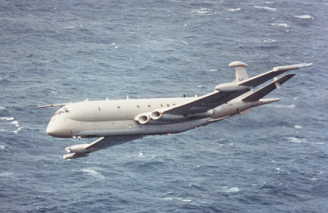
An R.A.F. NIMROD - The Mighty Hunter
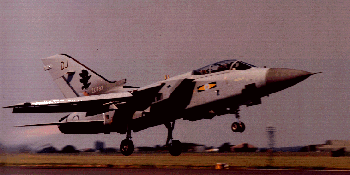
An R.A.F. TORNADO
The following images are the copyright of Paul Nann. They have been used with his kind permission, and his entire gallery of aeroplanes may be found here
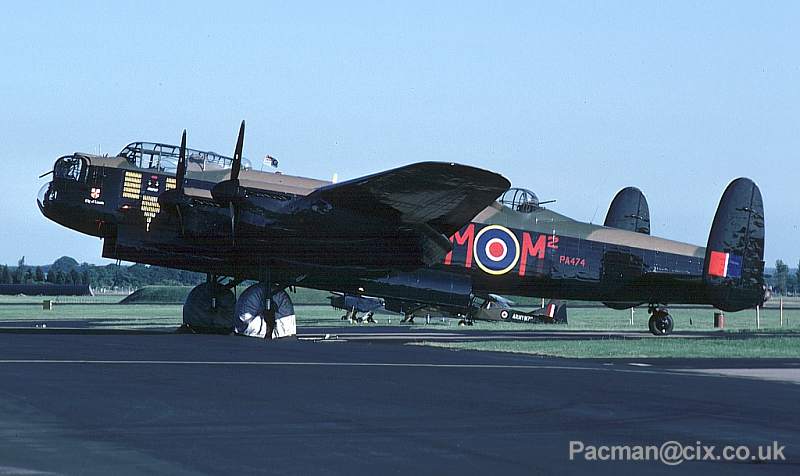
The Lancaster Bomber
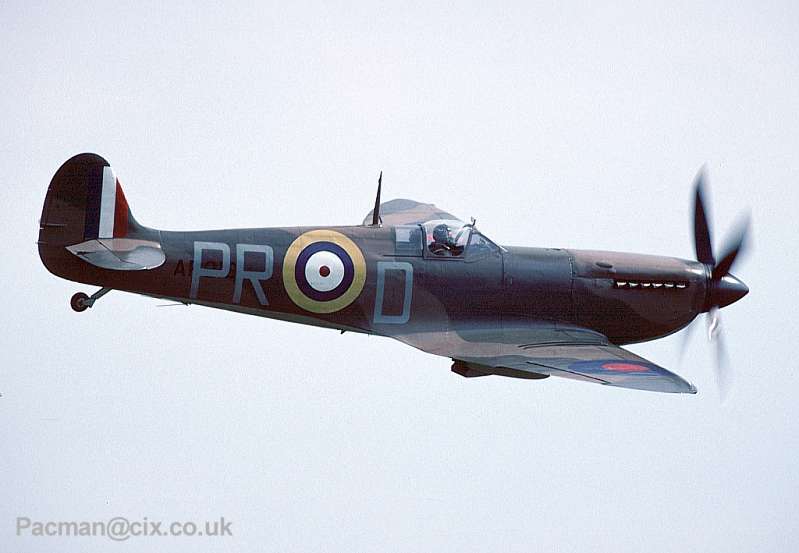
The Spitfire F1a

The Hurricane
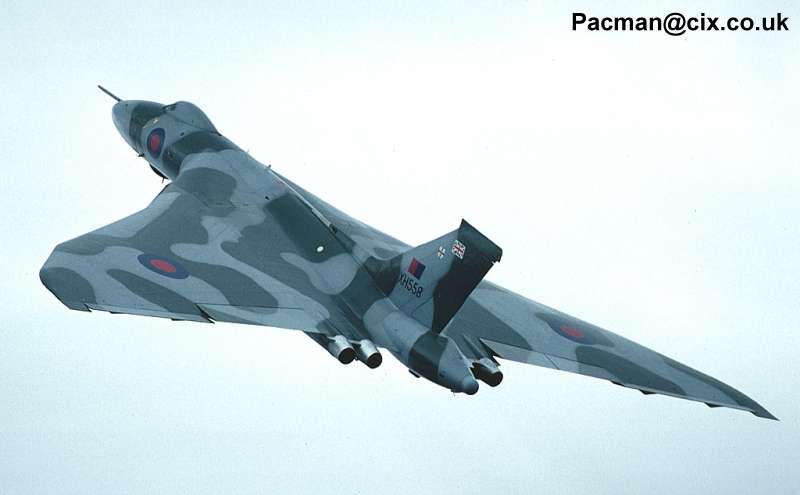
The Vulcan